Abstract
We have prepared a number of saponin-based vaccine adjuvant candidates. These unnatural saponins have a different terminal-functionalized side chain incorporated into the glucuronic acid unit that is attached to a triterpenoid core at its C3 position. The semisynthetic saponin adjuvants have shown significantly different immunostimulantory activities, suggesting that structure of the side chain, triterpenoid core, and oligosaccharide domain together orchestrate saponin adjuvant’s potentiation of immune responses. Among these new adjvuant candidates, VSA-2 (5b), a derivative of Momordica saponin II, showed consistent enhancement of IgG2a production when it was in formulation with either OVA or rHagB antigen. With rHagB antigen, it induced a significantly higher IgG2a responose than the positive control GPI-0100, a well-studied semisynthetic saponin adjuvant mixture derived from Quillaja saponaria Molina saponins, known for its ability to induce a balanced Th1/Th2 immunity. These results confirm that Momordica saponins are a viable natural source to provide potent saponin adjuvants after simple chemical derivatization, and identify VSA-2 (5b) as another MS-based promissing immunostimulant lead owing to its distinctive ability in potentiating IgG2a response.
Keywords: Adjuvant, Immunostimulant, Momordica saponins, VSA-2
Graphical Abstract
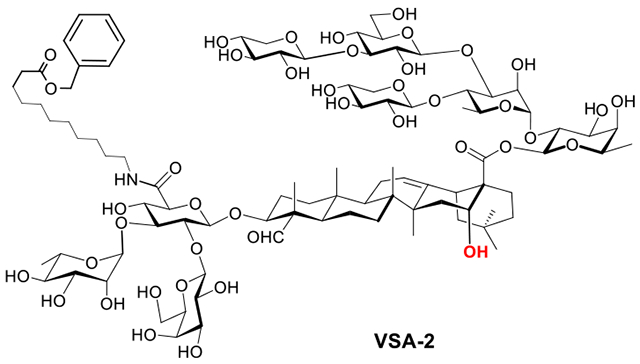
INTRODUCTION
Vaccine adjuvants are the substances used with a vaccine to potentiate host’s immune responses to the specific antigen(s) introduced by the vaccine.1–11 They can also tune immune system to the desirable responses for certain pathogens. For example, QS-21, a mixture of two isomers (Figure 1, 1), is a FDA-approved adjuvant known for its capacity of potentiating a balanced Th1/Th2 response with antigen-specific CTL production, which is valuable for vaccines against intracellular pathogens and cancers.12–15 It has potential for a wide range of clinical applications and thus to be in high demand.15 However, the supplies of QS-21 are very limited. The natural products are isolated from the tree bark of Quillaja saponaria Molina (QS), an evergreen tree native to warm temperate central Chile. Overexploitation of the natural source has resulted in ecological and economical consequences even under the current demand.16 Moreover, the abundance of QS-21 in QS tree bark extracts is low and its isolation is laborious.15–17 QS-21 also has a chemical instability issue due to two hydrolytically unstable ester moieties (as indicated in Figure 1) that complicates its formulation; and its dose-limiting toxicity prevents it from reaching the full potency.
Figure 1.

Natural saponin QS-21.
We have been in pursuit of practical alternatives to QS-21 in order to overcome its aforementioned drawbacks while inherit its favorable adjuvant activity profile.18–21 Recently, we demonstrated that derivatization of Momordica saponin (MS) I (2) and II (3) (Fig. 2) could potentially be a viable way to achieve the goal.22 MS I and II are isolated from the seeds of perennial Momordica cochinchinensis Spreng (MC) which grows in China and Southeast Asia.23 The seeds are widely available and inexpensive.24 Incorporation of an aliphatic dodecyl chain to MS I at the C3 glucuronic acid led to derivative VSA-1 (4a) with a significantly different adjuvant activity profile from the natural precursor (Fig. 2),22 in particular, in enhancing antigen-specific IgG2a response. Interestingly, MS II derivative 5a did not have such significant change in IgG1 and IgG2a responses from its natural saponin precursor 3 even though the two MS derivatives, 4a and 5a, only differ in their respective structure at C16 of the triterpenoid core (i.e., gypsogenin core (R1 = H) of 4a versus quillaic acid core (R1 = OH) of 5a).
Figure 2.
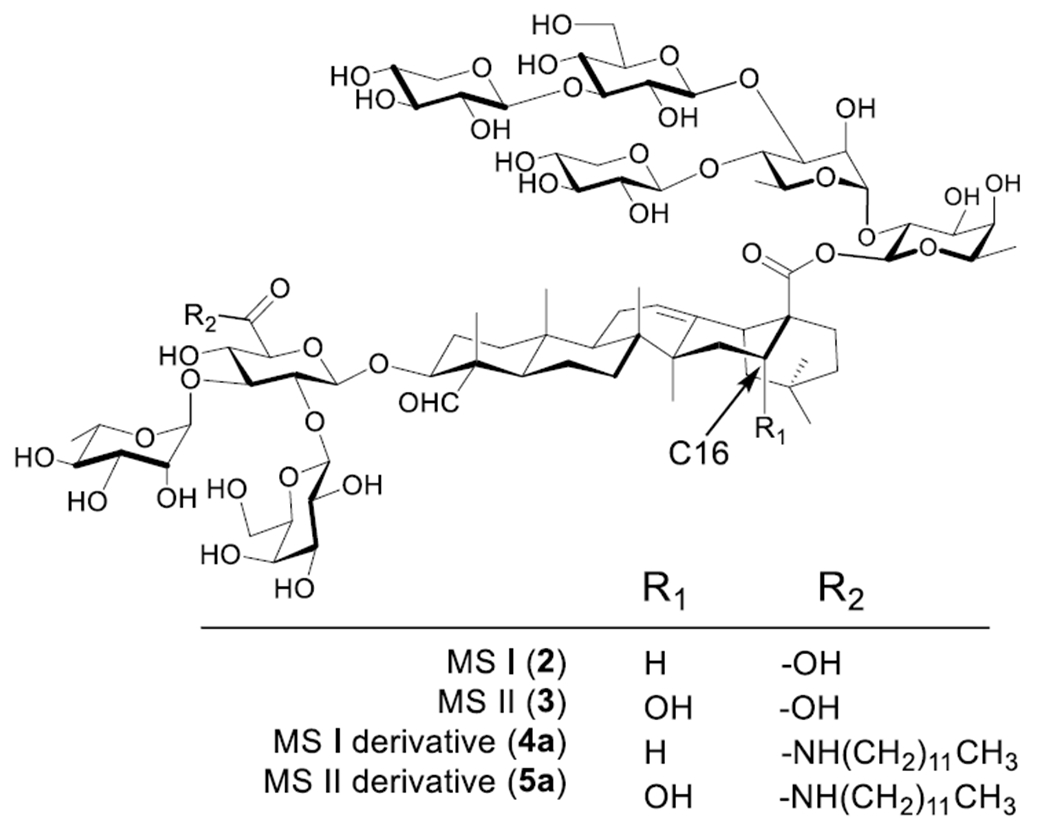
MS I (2), MS II (3), and their derivatives.
We previously demonstrated that QS-21 analogs bearing a plain dodecyl side chain (6, Figure 3) or a side chain with a terminal carboxyl group (7, Figure 3) could have different adjuvant activities; analog 7 showed significantly higher antigen-specific IgG1 and IgG2a titers in BALB/c mice and a higher IgG2a/IgG1 ratio than analog 6.18,19 Thus, in this work, we first conducted a SAR study to explore how the terminal-functionalized side chain would affect adjuvant activity of MS derivatives.
Figure 3.
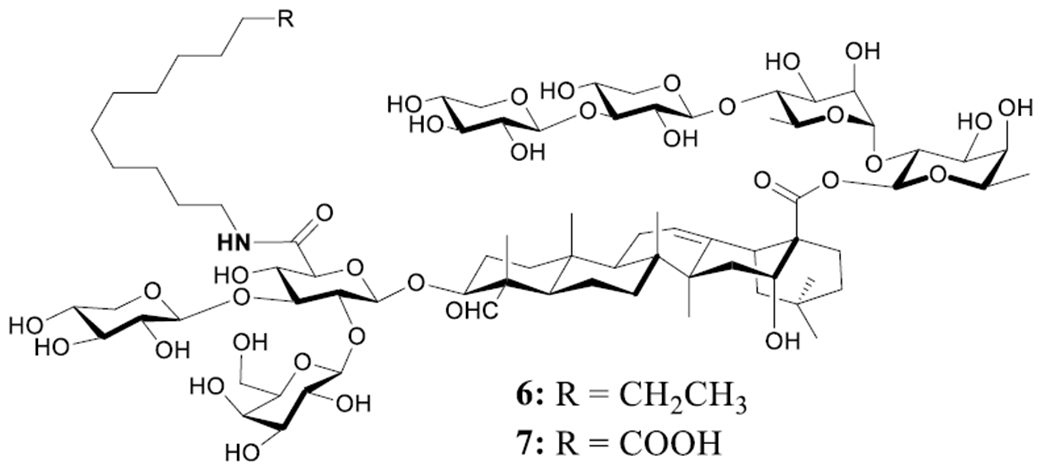
QS-21 derivatives with a different side chain.
RESULTS AND DISCUSSION
We prepared two MS I (2) derivatives 4b and 4c (Scheme 1). The side chain of 4b has a terminal ester group while 4c has the same side chain as QS-21 analog 7.19 Similarly, we also prepared two corresponding MS II (3) derivatives 5b and 5c. Preparation of these derivatives is straightforward. The two natural MS saponins (2 and 3) were isolated from commercially available and inexpensive MC seeds by using a published procedure.23 We then synthesized derivatives 4b and 5b from the respective natural saponins and the side chain25 by using a routine amide-formation method.26 Hydrogenolysis of 4b and 5b led to 4c and 5c, respectively, in high yields. Under the hydrogenolysis conditions, the C12 alkene moiety in the quillaic acid core remained intact.20
Scheme 1.
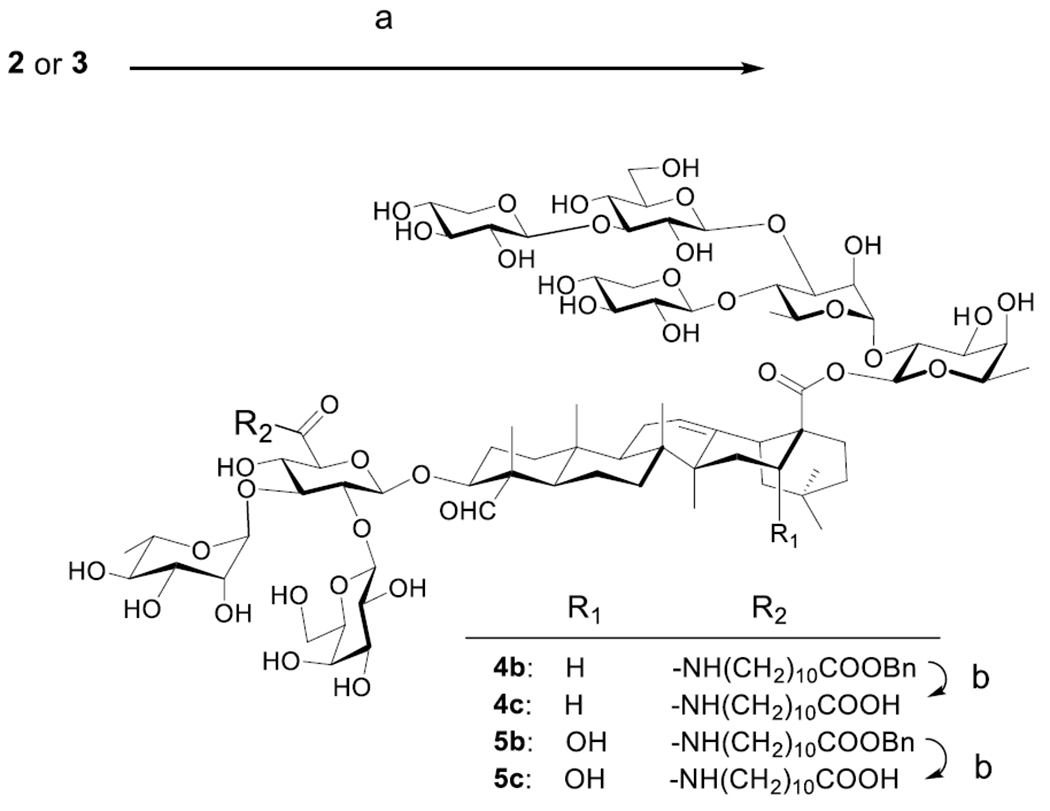
Derivatizing Momordica Saponinsa
a Reagents and conditions: (a) NMM, HOBt, EDC·HCl, NH2(CH2)10COOBn, H2O/EtOH, r.t., 78% for 4b and 72% for 5b; (b) Pd/C, H2 (55 psi), 98% for 4c and 96% for 5c.
We then evaluated their ability to potentiate antibody responses to chicken egg ovalbumin (OVA). We used the known saponin adjuvant GPI-0100 as one of the positive controls. GPI-0100 is a complex mixture of semi-synthetic sapoinins derived from QS tree bark extracts.27,28 Similar to the natural QS products, it potentiates humoral and T-cell immunity but with much lower toxicity.29 However, its complex composition is a formidable hurdle to its clinical use. We also used our recently reported MS derivative VSA-1 (4a) as the other positive control.22 Its high IgG1/IgG2a production and low toxicity are similar to that of GPI-0100. Thus, groups of female BALB/c mice (8-10 weeks of age, six per group) were immunized by the subcutaneous route (s.c.) with OVA (20 μg) alone or with GPI-0100, or a MS saponin derivative at 100 μg dose on days 0, 14 and 28. Mice were weighed and serum samples were collected prior to each immunization and at 2 weeks following the last immunization. The levels of serum antibody activity to OVA were determined by enzyme-linked immunosorbent assay (ELISA).
All groups of mice had a serum anti-OVA IgG response by week 2 after the initial immunization, and the level of IgG titers continued to increase at weeks 4 and 6 (Figure 4A). At weeks 4 and 6, all the adjuvant groups showed significantly higher IgG activity than the OVA control group without an adjuvant. The same trend appeared in anti-OVA IgG1 activities (Figure 4B), but at week 6, the OVA+5c group did not show statistical difference from the OVA control group. In terms of IgG2a activity (Figure 4c), the OVA control group remained the same activity over time while other groups with an adjuvant (except the OVA+5c group) showed steady increase of IgG2a titers at weeks 4 and 6. Adjuvant VSA-2 (5b) potentiated a significantly higher IgG2a activity than the OVA group (P < 0.01), OVA+4b (P < 0.05), and OVA+5c group (P < 0.01) at week 6, but showed no significant difference from the positive control groups and the OVA+4c group.
Figure 4.
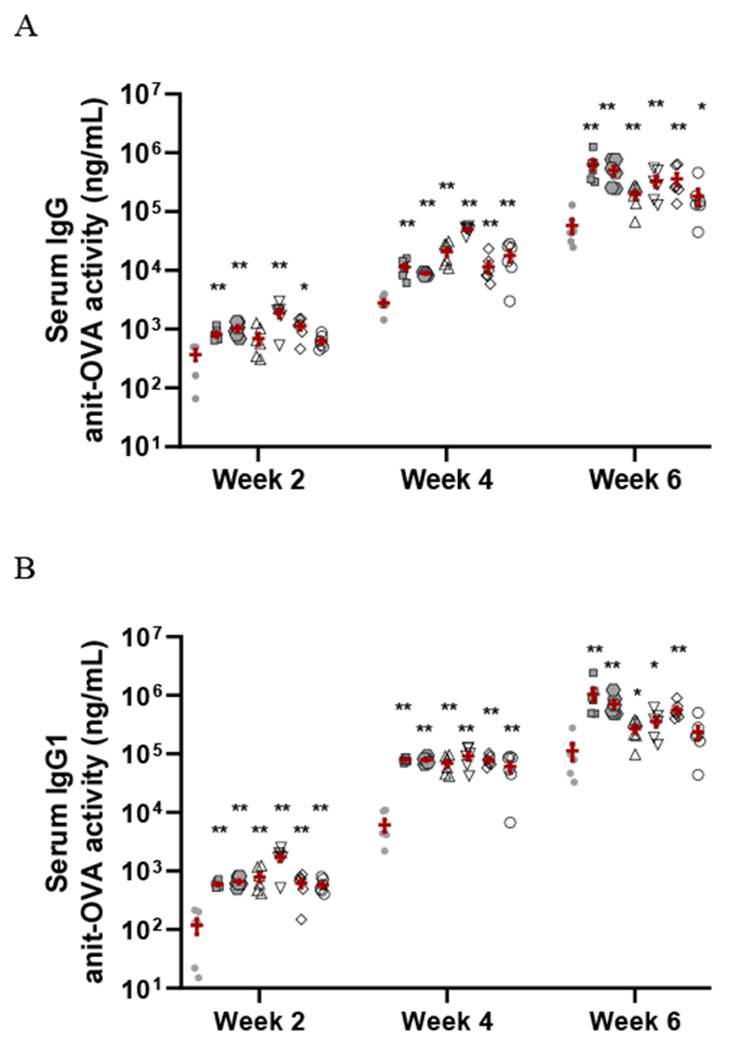
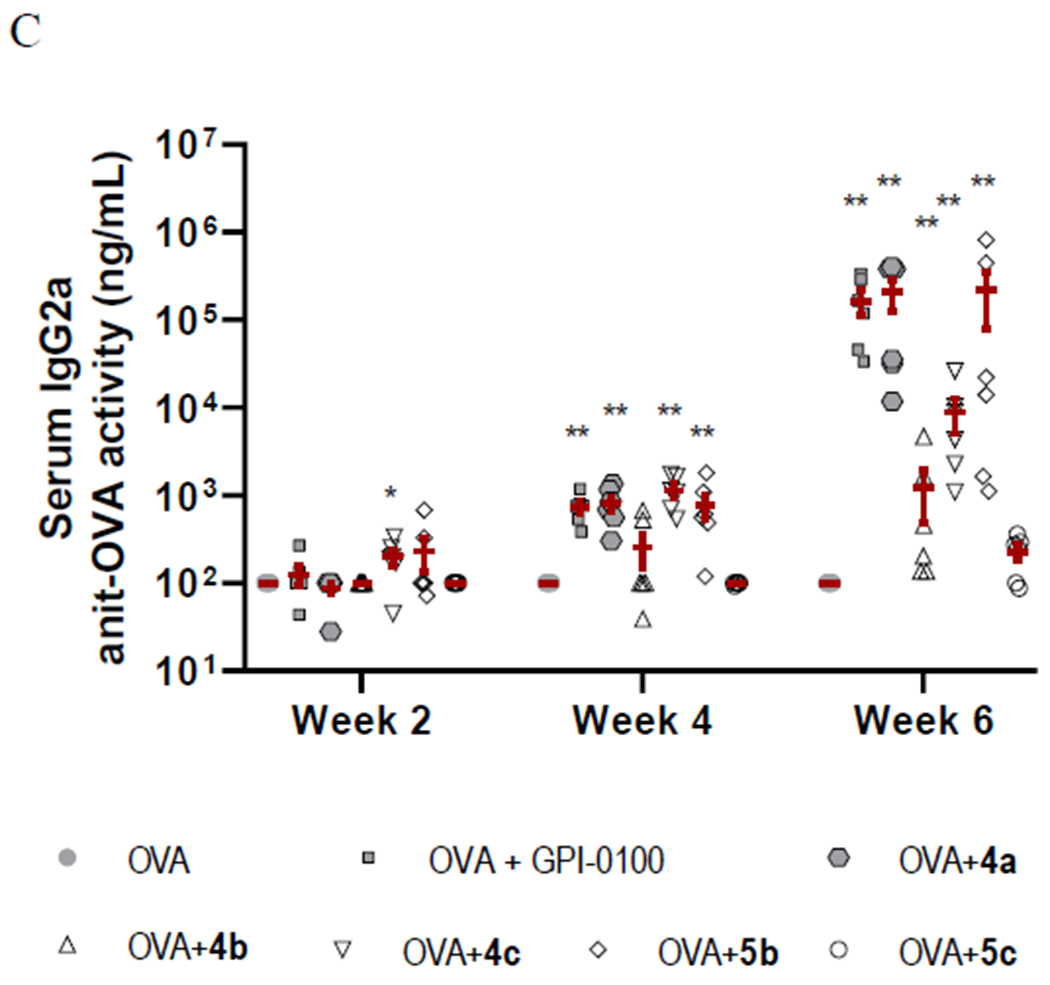
Serum IgG (A), IgG1 (B), and IgG2a (C) anti-OVA response in mice immunized by the s.c. route with OVA alone or with GPI-0100 or a MS derivative. Mice were immunized on days 0, 14 and 28. Serum samples were collected prior to each immunization and at 6 weeks after the initial immunization. Values are expressed as mean ± SEM. Statistical significance in antibody responses was evaluated by t tests (with unpaired, nonparametric and Mann-Whiteny test). * P < 0.05 and ** P < 0.01 compared with mice immunized with OVA alone.
Given the striking structural similarity between MS I/II (Figure 2) and de-acylated QS-17/18 (8) (Scheme 2), we synthesized the QS-17/18 derivatives similar to 5b/5c in order to see with the same side chain how the slight difference in C3 and C28 oligosaccharide domains would affect adjuvanticity. We previously synthesized and evaluated QS-17/18 derivative 9a,20 and by using the same synthetic route, we prepared new derivatives 9b and 9c. Thus, fully protected intermediate 10 first underwent debenzylation to remove all the benzyl protecting groups. The carboxyl group at C3 glucuronic acid was exposed. Under the hydrogenolysis conditions, all the triethylsilyl groups were removed as well. Subsequent amide-bond formation reaction installed the side chain as in the synthesis of 4b and 5b. After removal of the two acetyl groups on the fucosyl unit at C28 position under basic conditions, adjuvant candidate 9b was obtained. Debenzylation of 9b led to another adjuvant candidate 9c.
Scheme 2.
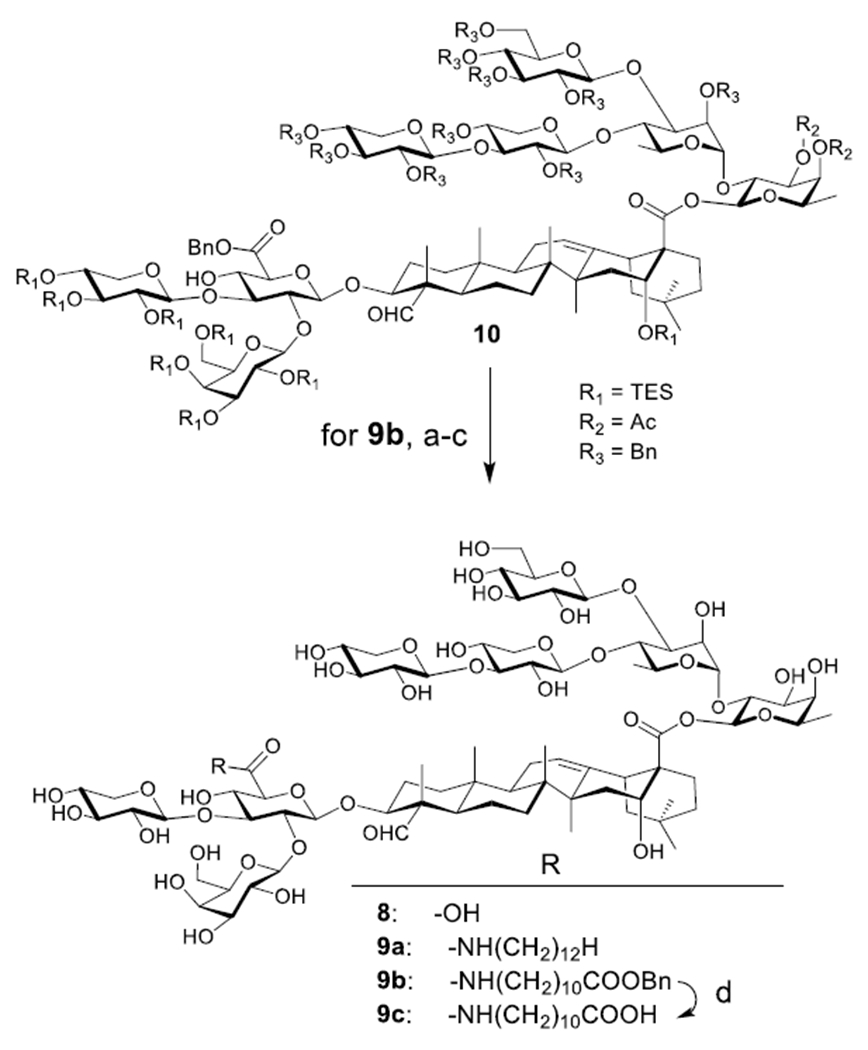
QS Saponin Analogs with Different Side Chainsa
aReagents and conditions: (a) Pd/C, H2 (55 psi); (b) NMM, HOBt, EDC·HCl, NH2(CH2)10COOBn, H2O/EtOH, r.t., 52% over two steps; (c) K2CO3, MeOH/H2O, 57%; (d) Pd/C, H2 (50 psi), 96%.
With 9b and 9c in hand, we then compared their capacity in potentiating antigen-specific antibody activity with that of 5b and 5c. We used an rHagB antigen which is a recombinant and non-fimbrial adhesion hemagglutinin B from Porphyromonas gingivalis,29–31 In earlier studies, it showed effectiveness in inducing protective immunity against P. gingivalis-induced alveolar bone loss.32 Thus, groups of female BALB/c mice (8-10 weeks of age, six per group) were immunized by the subcutaneous route (s.c.) with rHagB (35 μg) alone or with GPI-0100, a saponin adjuvant at 100 μg dose on days 0, 14 and 28. The same immunization and ELISA evaluation procedure as with OVA antigen were used.
As shown in Figure 5, all groups of mice showed a serum anti-rHagB IgG, IgG1, and IgG2a response by week 2 after the initial immunization, and the level of the antibody titers continued to grow at weeks 4 and 6 (Figure 5A–C). At weeks 2 and 4, all groups showed significantly higher IgG titers than the rHagB control group without an adjuvant, but at week 6, only the GPI-0100 group showed statistical difference from the rHagB group. The IgG1 response had a similar trend as seen in IgG (Figure 5B), but at week 6, the OVA+9a and OVA+9b groups showed statistical difference from the rHagB group. For IgG2a response, all groups showed significantly higher activity than the rHagB control group at weeks 2, 4, and 6 (Figure 5C). It is noteworthy that VSA-2 (5b) potentiated significantly higher IgG2a than the positive control GPI-0100 at week 4 (P < 0.05) and week 6 (P < 0.05). VSA-2 (5b) also showed significantly higher IgG2a activity than QS-17/18 derivative 9b at week 2 (P < 0.01), week 4 (P < 0.01), and week 6 (P < 0.01), and 9c at week 2 (P < 0.05), week 4 (P < 0.01), and week 6 (P < 0.01). Different from with OVA antigen (Figure 4c), VSA-2 (5b) did not show significant difference from 5c in potentiating IgG2a response.
Figure 5.
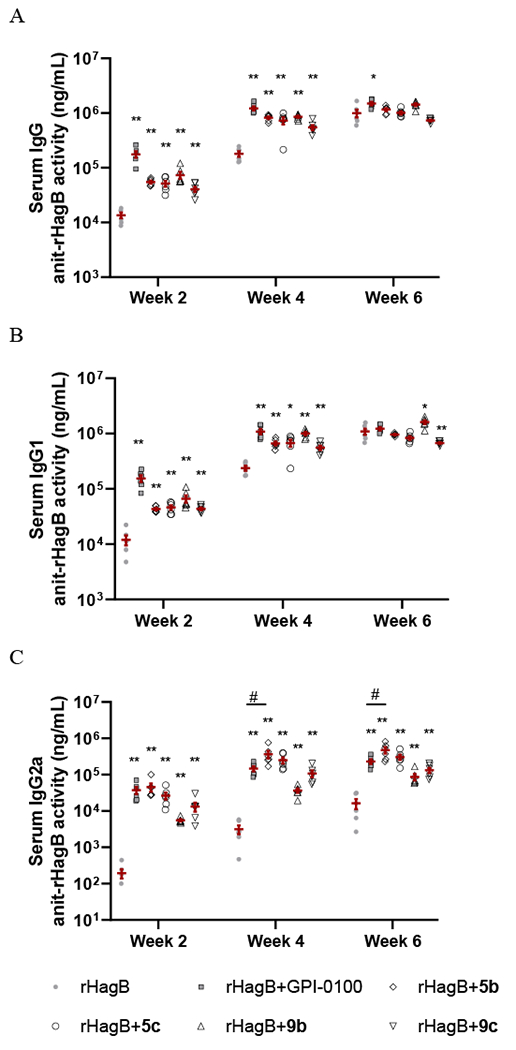
Serum IgG (A), IgG1 (B), and IgG2a (C) anti-rHagB response in mice immunized by the s.c. route with rHagB alone or with GPI-0100 or a saponin adjuvant. Mice were immunized on days 0, 14 and 28. Serum samples were collected prior to each immunization and at 6 weeks after the initial immunization. Values are expressed as mean ± SEM. Statistical significance in IgG, IgG1, and IgG2a antibody responses was evaluated by t tests (with unpaired, nonparametric and Mann-Whiteny test). * P < 0.05, and ** P < 0.01 compared with mice immunized with rHagB alone, # P < 0.05, compared between the indicated groups.
Since production of IgG1 or IgG2a in mice is enhanced by the respective Th2 or Th1 cytokines, their relative amount can be used as a tentative indication of involvement of Th2 and Th1 immunity potentiated by the adjuvant.33 With rHagB antigen, VSA-2 (5b) showed a significantly higher IgG2a/IgG1 ratio than other groups (except 5c) at weeks 2, 4, and 6 (Figure 6). These results suggest that 5b (and 5c) could be capable of boosting Th1 immunity more than GPI-0100 could, which would be valuable when a strong Th1 immunity is desired.
Figure 6.
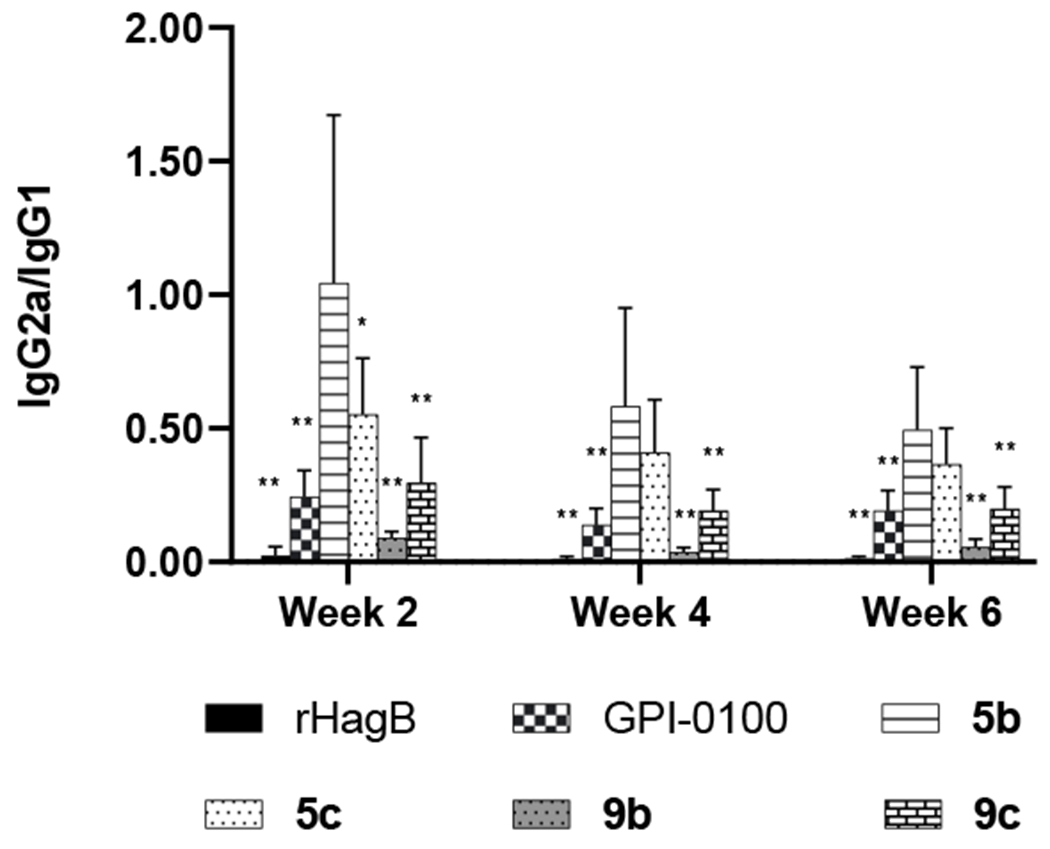
Ratio of Serum anti-rHagB IgG2a and IgG1 activity (IgG2a/IgG1).Values are expressed as mean ± SD. Statistical significance compared with rHagB+VSA-2 (5b), Statistical significance was evaluated by t tests (with unpaired, nonparametric and Mann-Whiteny test). *P < 0.05, **P < 0.01.
Immunological evaluations of the semisynthetic MS derivatives and synthetic QS analogs revealed that with different protein antigens (i.e., OVA or rHagB), VSA-2 (5b) showed a comparable or higher IgG2a/IgG1 ratio than GPI-0100 with a similar overall IgG production. In our previous study with OVA antigen, MS derivative 4a enhanced IgG2a production significantly higher than 5a;22 in this work, 4a and 5b showed similar IgG2a productions (no significant difference, Figure 4C). The only difference between 5a and 5b is their side chain, suggesting that the structure of the side chain affects the antibody activity profile of the induced immunological response. Moreover, with a different side chain, derivatives 5b and 5c also showed different antibody activities when they were immunized with the OVA antigen but similar activities when with the rHagB antigen. With the same side chain, saponins 4b, 5b, and 9b, having different core structures, showed different antibody activities. The two saponins, 4b and 5b, only differ in their respective triterpenoid core, with 5b having an extra C16 OH (quillaic acid core) compared with 4b’s gypsogenin core. Saponins 5b and 9b have the identical triterpenoid core (i.e., quillaic acid) and side chain, but they slightly differ at the C3 and C28 oligosaccharide domains. All these saponins have an overall similar structure thus similar hydrophile-lipophile balance (HLB),34 and they showed similar overall IgG activities. However, their capability of potentiating IgG2a production differs significantly, which suggests that the specific structure of a saponin, i.e., the structural details of the side chain, triterpenoid core, and oligosaccharide domains, affects the details of an immune response.
CONCLUSIONS
We prepared a number of MS- and QS-saponin-based vaccine adjuvant candidates. The MS derivatives were prepared by incorporating a terminal-functionalized side chain into the C3 glucuronic acid unit of the natural MS I and II through amide formation reaction; and the QS analogs were prepared via multi-step organic synthesis. These unnatural saponins showed significantly different immunostimulant activity profiles, suggesting that the structure of side chain, triterpenoid core, and oligosaccharide domain together orchestrate each saponin’s characteristic potentiation of immune responses. Among the various adjvuant candidates, VSA-2 (5b), a derivative of MS II, constantly enhanced IgG2a production when it was immunized with either OVA or rHagB antigen. With antigen rHagB, it induced a significantly higher IgG2a responose than the positive control GPI-0100, a well-studied semisynthetic saponin adjuvant derived from QS saponins known for its ability to induce a balanced Th1/Th2 immunity. These results confirm that Momordica saponins are a viable natural source for preparation of unnatural saponin adjuvants with different adjuvant activities through simple chemical derivatization, and identify VSA-2 (5b) as another promissing MS-based immunostimulant (in addition to the previsously reported VSA-1 (4a)) for further development owing to its distinctive ability in potentiating IgG2a response.
EXPERIMENTAL SECTION
Chemistry.
General.
Organic solutions were concentrated by rotary evaporation at ca. 12 Torr. Flash column chromatography was performed employing 230-400 mesh silica gel. Thin-layer chromatography was performed using glass plates pre-coated to a depth of 0.25 mm with 230-400 mesh silica gel impregnated with a fluorescent indicator (254 nm). Infrared (IR) data are presented as frequency of absorption (cm−1). Proton and carbon-13 nuclear magnetic resonance (1H NMR or 13C NMR) spectra were recorded on 400, 700, and 850 MHz NMR spectrometers; Chemical shifts are expressed in parts per million (δ scale) downfield from tetramethylsilane and are referenced to residual protium in the NMR solvent (CHCl3: δ=7.26). Data are presented as follows: chemical shift, multiplicity (s = singlet, d = doublet, t = triplet, q = quartet, m = multiplet and/or multiple resonances, AB = AB quartet), coupling constant in Hertz (Hz), integration. Anhydrous solvents were used without distillation. Solvents for workup and column chromatography, were obtained from commercial vendors and used without further purification. The purity of the products for immunological studies was determined by a combination of HPLC and 1H NMR, and found to be ≥95%. All in vivo studies were performed in accordance with local IACUC guidelines.
General procedure of derivatizing MS I and II:
Momordica saponins were isolated by using the published procedure.23 To a clear solution of MS I (2) (15.8 mg, 9.4 μmol) in ethanol (0.5 mL) and water (drops) was added 11-aminoundecanoic acid benzyl ester hydrochloride (6.6 mg, 20 μmol),25 N-methylmorpholine (NMM) (12.0 mg, 118 μmol), hydroxybenzotriazole (HOBt) (9.2 mg, 60 μmol), and 1-ethyl-3-(3-dimethylaminopropyl)carbodiimide hydrochloride (EDC·HCl) (12.0 mg, 63 μmol) at room temperature.26 The reaction mixture was stirred for 1 day and then filtered. The filtrate was purified with RP HPLC by using a semi-Prep C18, 250x10 mm, 5 micron column and H2O/MeCN gradients (90%-10% H2O over 45 minutes with a 3 mL/min flow rate). The desired product had a retention time of 30 min and the fraction was concentrated on a rotary evaporator at room temperature to remove MeCN, and the remaining water was then removed on a lyophilizer to provide final product 4b or 5b as a white solid. To prepare 4c or 5c, for example, a mixture of MeOH (4.0 mL) and H2O (0.4 mL) was added to 4b (60.0 mg, 31 μmol) and 10% Pd/C (10.0 mg), and then treated with hydrogen (50 psi) for two hours. The suspension was filtered through a celite plug and concentrated to provide desired 4c (56.0 mg, 98%) as a white solid.
For 4b (14.4 mg, 78%), 1H NMR (600 MHz, CD3OD) (characteristic protons) δ 9.49 (s, 1H), 7.41-7.37 (m, 4H), 7.35 (m, 1H), 5.36 (d, J = 1.5 Hz, 1H), 5.34 (d, J = 8.2 Hz, 1H), 5.29 (t, J = 3.3 Hz, 1H), 5.15 (s, 2H), 5.05 (d, J = 1.5 Hz, 1H), 4.67 (d, J = 7.9 Hz, 1H), 4.60 (d, J = 7.8 Hz, 1H), 4.52 (d, J = 7.6 Hz, 1H), 4.51 (d, J = 6.9 Hz, 1H), 4.48 (d, J = 7.2 Hz, 1H), 4.29 (t, J = 2.4 Hz, 1H), 4.04 (dd, J = 3.2, 1.9 Hz, 1H), 4.01 (dd, J = 11.4, 5.3 Hz, 1H), 3.16 (t, J = 10.9 Hz, 1H), 3.07 (dd, J = 9.1, 8.0 Hz, 1H), 2.83 (dd, J = 12.9, 3.6 Hz, 1H), 2.40 (t, J = 7.4 Hz, 2H), 2.07 (td, J = 12.8, 2.3 Hz, 1H), 1.02 (s, 3H), 0.94 (s, 3H), 0.93 (s, 3H), 0.83 (s, 3H); 13C NMR (150.9 MHz, CD3OD) δ 209.3, 176.5, 173.8, 169.9, 169.8, 143.6, 136.4, 128.2, 127.9, 127.8, 121.8, 104.6, 103.9, 103.7, 102.8, 102.5, 101.8, 100.0, 94.0, 87.3, 84.4, 84.1, 81.5, 77.7, 77.6, 76.6, 76.1, 76.0, 75.4, 74.8, 74.5, 74.0, 73.6, 73.0, 72.8, 72.4, 72.2, 71.6, 71.3, 70.8, 70.7, 70.5, 70.1, 69.9, 69.6, 69.2, 69.1, 68.1, 67.4, 65.8, 65.7, 65.6, 60.8, 54.9, 46.6, 46.0, 41.8, 41.6, 39.6, 38.9, 38.7, 38.0, 35.7, 33.7, 33.5, 32.2, 32.1, 31.5, 30.1, 29.2, 29.1, 29.0, 28.9, 28.8, 27.5, 26.5, 24.8, 24.7, 24.4, 23.2, 22.8, 22.6, 20.2, 17.1, 16.5, 16.4, 15.1, 15.0, 9.5; HRMS (ESI-TOF) m/z: [M+H]+ calcd for C94H148NO41 1946.9527; found 1946.9496.
For 4c (56.0 mg, 98%), 1H NMR (600 MHz, CD3OD) (characteristic protons) δ 9.48 (s, 1H), 5.35-5.32 (m, 2H), 5.28 (s, 1H), 5.05 (s, 1H), 4.46 (d, J = 7.8 Hz, 1H), 4.60 (d, J = 7.8 Hz, 1H), 4.51 (d, J = 7.5 Hz, 2H), 4.48 (m, 1H), 4.28 (s, 1H), 4.05 (s, 1H), 4.01 (dd, J = 11.3, 5.1 Hz, 1H), 3.16 (t, J = 11.0 Hz, 1H), 3.07 (t, J = 8.5 Hz, 1H), 2.83 (d, J = 10.4 Hz, 1H), 2.31 (t, J = 7.4 Hz, 1H), 2.07 (t, J = 13.2 Hz, 1H),1.02 (s, 3H), 0.81 (s, 3H); 13C NMR (150.9 MHz, CD3OD) δ 209.4, 176.5, 176.3, 169.8, 143.5, 121.8, 104.6, 103.9, 103.6, 102.8, 102.5, 101.9, 100.0, 94.0, 87.2, 84.4, 84.2, 81.5, 77.6, 76.6, 76.1, 76.0, 75.4, 74.8, 74.5, 74.0, 73.6, 73.01, 72.98, 72.4, 72.2, 71.6, 71.3, 70.8, 70.6, 70.5, 70.1, 69.9, 69.6, 69.2, 69.1, 68.1, 67.5, 65.7, 65.6, 60.8, 54.9, 46.6, 46.0, 41.8, 41.6, 39.6, 38.8, 38.0, 35.7, 33.6, 32.2, 31.6, 30.2, 29.4, 29.2, 29.14, 29.11, 28.9, 27.5, 26.5, 24.9, 24.7, 24.4, 23.2, 22.8, 22.7, 20.2, 17.1, 16.6, 16.4, 15.2, 15.0, 9.5; HRMS (ESI-TOF) m/z: [M+H]+ calcd for C87H142NO41 1856.9057; found 1856.8998.
For 5b (12.5 mg, 72%), 1H NMR (700 MHz, CD3OD) (characteristic protons) δ 9.51 (s, 1H), 7.39-7.38 (m, 4H), 7.34 (m, 1H), 5.44 (d, J = 1.5 Hz, 1H), 5.34 (t, J = 3.2 Hz, 1H), 5.24 (d, J = 8.3 Hz, 1H), 5.15 (s, 2H), 5.05 (d, J = 1.3 Hz, 1H), 4.75 (d, J = 7.9 Hz, 1H), 4.57 (d, J = 7.8 Hz, 1H), 4.54 (s, 1H), 4.52-4.47 (m, 2H), 4.46 (d, J = 7.6 Hz, 1H), 4.26 (t, J = 3.2, 1.8 Hz, 1H), 4.06-4.02 (m, 2H), 3.19 (t, J = 10.7 Hz, 1H), 3.15 (dd, J = 9.2, 8.1 Hz, 1H), 2.92 (dd, J = 9.4, 4.2 Hz, 1H), 2.40 (t, J = 7.3 Hz, 2H), 2.31 (t, J = 13.6 Hz, 1H), 1.44 (s, 3H), 1.26 (d, J = 6.2 Hz, 3H), 1.24 (d, J = 6.4 Hz, 3H),1.19 (s, 3H), 1.21 (s, 3H), 1.04 (s, 3H), 0.95 (s, 3H), 0.89 (s, 3H), 0.82 (s, 3H); 13C NMR (150.9 MHz, CD3OD) δ 209.6, 175.5, 173.8, 169.8, 143.5, 136.4, 128.2, 128.1, 127.9, 127.8, 121.5, 104.7, 103.8, 103.5, 102.8, 102.7, 101.9, 99.3, 94.0, 87.4, 84.6, 84.5, 82.1, 77.3, 76.8, 76.4, 76.0, 75.42, 75.38, 75.1, 74.2, 74.0, 73.6, 73.3, 73.0, 72.4, 72.3, 71.6, 71.51, 71.45, 70.8, 70.7, 70.5, 70.1, 70.0, 69.6, 69.2, 69.1, 68.0, 67.4, 65.8, 65.7, 60.8, 60.6, 54.8, 48.5, 46.6, 41.6, 41.1, 39.7, 38.7, 38.0, 35.7, 35.2, 33.7, 32.8, 32.0, 30.5, 29.9, 29.4, 29.2, 29.1, 29.0, 28.9, 28.7, 26.5, 25.9, 24.7, 23.3, 23.1, 20.0, 17.0, 16.5, 16.4, 15.1, 9.6; HRMS (ESI-TOF) m/z: [M+H]+ calcd for C94H148NO42 1962.9476; found 1962.9436.
For 5c (11.0 mg, 96%), 1H NMR (700 MHz, CD3OD) (characteristic protons) δ 9.51 (s, 1H), 5.44 (d, J = 1.3 Hz, 1H), 5.35 (t, J = 3.4 Hz, 1H), 5.25 (d, J = 8.3 Hz, 1H), 5.05 (s, 1H), 4.75 (d, J = 7.8 Hz, 1H), 4.57 (d, J = 7.9 Hz, 1H), 4.54 (s, 1H), 4.45-4.47 (m, 2H), 4.46 (d, J = 7.6 Hz, 1H), 4.25 (s, 1H), 4.06-4.00 (m, 2H), 3.19 (t, J = 11.3 Hz, 1H), 3.15 (dd, J = 9.3, 8.1 Hz, 1H), 2.31 (t, J = 13.9 Hz, 1H), 2.29 (t, J = 7.5 Hz, 2H), 1.44 (s, 3H), 1.21 (s, 3H), 1.05 (s, 3H), 0.97 (s, 3H), 0.90 (s, 3H), 0.82 (s, 3H); HRMS (ESI-TOF) m/z: [M+H]+ calcd for C87H142NO42 1872.9006; found 1872.9016.
Preparation of 9b and 9c: Known conjugate 10 (30.0 mg, 7.9 mmol)20 and 10% Pd/C (6.0 mg) in 1.5 mL of THF/MeOH (2:1) were subjected to hydrogen gas at 55 psi for 16 h. The suspension was then filtered through a celite plug, concentrated, and re-dissolved in 0.6 mL of EtOH/H2O (v/v 5:1). To the solution was added 11-aminoundecanoic acid benzyl ester hydrochloride (6.4 mg, 20 μmol),25 N-methylmorpholine (NMM) (13.0 mg, 127 μmol), hydroxybenzotriazole (HOBt) (8.8 mg, 58 μmol), and 1-ethyl-3-(3-dimethylaminopropyl)carbodiimide hydrochloride (EDC·HCl) (11.4 mg, 58 μmol) at room temperature.26 The reaction mixture was stirred for 1 day and then filtered. The filtrate was purified with RP HPLC by using a semi-Prep C18, 250x10 mm, 5 micron column and H2O/MeCN gradients (90%-10% H2O over 30 minutes with a 3 mL/min flow rate). The desired product had a retention time of 23 min and the fraction was concentrated on a rotary evaporator at room temperature to remove MeCN, and the remaining water was then removed on a lyophilizer to provide the intermediate as a white solid (8.0 mg, 52%) over two steps. The intermediate was dissolved in methanol (0.5 mL) and H2O (0.3 mL) and treated with K2CO3 (20 mg) overnight. The reaction mixture was neutralized with acetic acid, and purified with with RP HPLC by using a semi-Prep C18, 250x10 mm, 5 micron column and H2O/MeCN gradients (90%-10% H2O over 45 minutes with a 3 mL/min flow rate). The desired product had a retention time of 23 min and the fraction was concentrated on a rotary evaporator at room temperature to remove MeCN, and the remaining water was then removed on a lyophilizer to provide 9b (4.4 mg, 57%) as a white solid. By using the same debenzylation procedure described for 4c/5c, 9c was obtained (4.0 mg, 96%) as a white solid.
For 9b, 1H NMR (600 MHz, CD3OD) (characteristic protons) δ 9.38 (s, 1H), 7.87 (t, J = 5.5 Hz, 1H), 7.27-7.24 (m, 4H), 7.22 (m, 1H), 5.22-5.19 (m, 2H), 5.17 (d, J = 8.2 Hz, 1H), 5.03 (s, 2H), 4.71 (d, J = 7.7 Hz, 1H), 4.63 (d, J = 7.9 Hz, 1H), 4.48 (d, J = 7.8 Hz, 1H), 4.44 (d, J = 7.7 Hz, 1H), 4.41 (d, J = 7.5 Hz, 1H), 4.38 (s, 1H), 4.34 (d, J = 7.4 Hz, 1H), 4.16 (dd, J = 2.9, 1.9 Hz, 1H), 2.85 (dd, J = 13.9, 4.0 Hz, 1H), 2.28 (t, J = 7.3 Hz, 2H), 2.21 (t, J = 13.3 Hz, 1H), 1.29 (s, 3H), 1.11 (d, J = 6.4 Hz, 3H), 1.07 (s, 3H), 0.90 (s, 3H), 0.84 (s, 3H), 0.78 (s, 3H), 0.66 (s, 3H); 13C NMR (176.0 MHz, CD3OD) δ 211.4, 177.1, 175.2, 170.8, 145.0, 137.8, 129.6, 129.3, 129.2, 123.1, 105.9, 105.3, 105.0, 104.8, 104.7, 103.7, 101.7, 95.3, 95.2, 88.3, 87.0, 86.3, 83.0, 78.9, 78.23, 78.20, 78.0, 77.8, 77.7, 77.0, 76.4, 76.3, 75.37, 75.34, 75.26, 75.0, 74.9, 74.6, 73.6, 73.5, 72.7, 71.4, 71.3, 71.1, 71.0, 70.7, 69.9, 68.9, 67.2, 66.6, 62.3, 61.9, 56.3, 42.7, 42.2, 41.1, 40.1, 39.4, 37.1, 36.6, 36.5, 35.1, 33.8, 33.4, 32.1, 31.3, 30.8, 30.6, 30.52, 30.45, 30.3, 30.2, 27.9, 27.3, 26.1, 26.0, 24.8, 24.5, 21.6, 18.7, 17.8, 16.52, 16.45, 11.0; HRMS (ESI-TOF) m/z: [M+Na]+ calcd for C93H145NO42Na 1970.9139; found 1970.9172.
For 9c, 1H NMR (700 MHz, CD3OD) (characteristic protons) δ 9.50 (s, 1H), 7.95 (t, J = 5.9 Hz, 1H), 5.36-5.32 (m, 2H), 5.30 (d, J = 8.2 Hz, 1H), 4.75 (d, J = 7.9 Hz, 1H), 4.60 (d, J = 7.8 Hz, 1H), 4.56 (d, J = 7.7 Hz, 1H), 4.54 (d, J = 7.6 Hz, 1H), 4.50 (s, 1H), 4.46 (d, J = 7.5 Hz, 1H), 4.29 (dd, J = 3.2, 1.7 Hz, 1H), 2.98 (dd, J = 14.1, 3.8 Hz, 1H), 2.33 (t, J = 13.8 Hz, 1H), 2.33 (t, J = 7.4 Hz, 2H), 1.41 (s, 3H), 1.31 (d, J = 6.2 Hz, 3H), 1.24 (d, J = 6.4 Hz, 3H), 1.21 (s, 3H), 1.03 (s, 3H), 0.98 (s, 3H), 0.91 (s, 3H), 0.79 (s, 3H); HRMS (ESI-TOF) m/z: [M+Na]+ calcd for C86H139NO42Na 1880.8669; found 1880.8645.
Antigens.
The chicken egg albumin for in vivo use (Vac-pova) was purchased from InvivoGen. Recombinant Porphyromonas gingivalis HagB was prepared as previously described.29–31 Briefly, the HagB gene was cloned from P. gingivalis 381 into a pET vector with a lac promoter and histidine tag and expressed in Escherichia coli JM109 (kindly provided by Ann Progulske-Fox and Thomas Brown, University of Florida, Gainesville). Protein expression was induced following isopropyl-β-D-thiogalactopyranoside (IPTG) induction. rHagB was purified from the soluble fraction of the bacterial lysates by using a His-bind resin column, according to the manufacturer’s instruction (Novagen, Madison, WI). The purity of rHagB was confirmed by silver staining and Western blot analysis using a rabbit anti-rHagB antibody. The concentration of rHagB was estimated by the bicinchoninic acid protein determination assay (Pierce, Rockford, IL), using bovine serum albumin (BSA) as the standard.
Mice and immunization.
BALB/c mice used in this study were purchased from Frederick Cancer Research (Fredrick, MD) and maintained within an environmentally controlled, pathogen-free animal facility at the University of Alabama at Birmingham (UAB). To assess the adjuvant activity of the MS saponin-based immune adjuvants, groups of female mice (8-10 weeks of age; 6 mice per group) were immunized by the subcutaneous (s.c.) route with OVA (20 μg) or rHagB (35 μg) alone, or with antigen plus proper adjuvant such as GPI-0100 (100 μg) or a MS adjuvant (100 μg) on days 0, 14 and 28. Prior to each immunization and at two weeks post last immunization, mice were weighed and blood samples were collected from the lateral tail vein by using heparinized capillary pipettes. The serum was obtained after centrifugation and stored at −20 °C until assayed. All studies were performed according to National Institutes of Health guidelines, and protocols were approved by the UAB Institutional Animal Care and Use Committee.
Evaluation of antibody responses.
The levels of specific serum IgG and IgG subclasses against OVA or rHagB in each group were determined by an enzyme-linked immunosorbent assay (ELISA). Maxisorpmicrotiter plates (NUNC International, Roskilde, Denmark) were coated with rHagB (1 μg/ml), OVA (0.1 μg/ml), or with optimal amounts of goat anti-mouse IgG, IgG1 or IgG2a (Southern Biotechnology Associates, Inc., Birmingham, AL) in borate buffer saline (BBS; 100 mM NaCl, 50 mM boric acid, 1.2 mM Na2B407, pH 8.2) at 4°C overnight. Plates were blocked with 1% bovine serum albumin (BSA) and 0.02% sodium azide in BBS for 2 h at room temperature. Serial two-fold dilutions of serum samples were added in duplicate to the plates. To generate standard curves, serial dilutions of a mouse immunoglobulin reference serum (MP Biomedicals, Solon, OH) were added to two rows of wells in each plate that had been coated with the appropriate anti-mouse IgG or IgG subclass reagent. After incubation (overnight at 4°C) and washing of the plates, horseradish peroxidase-conjugated goat anti-mouse IgG or IgG subclass antibody (Southern Biotechnology Associates, Inc.) was added to appropriate wells. After 4 h of incubation at room temperature, plates were washed and developed by o-phenylenediamine substrate with hydrogen peroxide. Color development was recorded at 490 nm. The concentrations of antibodies were determined by interpolation on standard curves generated by using the mouse immunoglobulin reference serum and constructed by a computer program based on four-parameter logistic algorithms (Softmax/Molecular Devices Corp., Menlo Park, CA).
Statistical analysis.
Statistical significance in antibody responses was evaluated by t tests (with unpaired, nonparametric and Mann-Whiteny test) using GraphPad Prism 8. Differences were considered significant at a P value < 0.05.
Supplementary Material
ACKNOWLEDGMENT
This work was supported by NIH Grant R01 GM120159 to P.W.
ABBREVIATIONS USED
- IgG
immunoglobulin G
- Th
T helper cells
- CTL
cytotoxic T cell
- rha
rhamnose
- xyl
xylose
- OVA
ovalbumin
- NMM
N-methylmorpholine
- HOBt
hydroxybenzotriazole
- EDC·HCl
1-ethyl-3-(3-dimethylaminopropyl)carbodiimide
- DCM
dichloromethane
- MeCN
acetonitrile
- THF
tetrahydrofuran
- rHagB
recombinant hemagglutinin B
- s.c
subcutaneous
- ESI-TOF
electrospray ionization time-of-flight mass spectrometry
- ELISA
enzyme-linked immunosorbent assay
- IACUC
International Animal Care and Use Committee
Footnotes
Supporting Information Available:
1H and 13C NMR spectra of the new compounds 4b, 4c, 5b, 5c, 9b, and 9c (PDF)
Molecular formula strings (CSV)
The authors declare the following competing financial interest(s): P.W. is inventor on patent applications based on this work.
REFERENCES
- (1).Brunner R; Jensen-Jarolim E; Pali-Scholl I The ABC of clinical and experimental adjuvants--a brief overview. Immunol. Lett 2010, 128, 29–35. [DOI] [PMC free article] [PubMed] [Google Scholar]
- (2).Kensil CR; Mo AX; Truneh A Current vaccine adjuvants: An overview of a diverse class. Frontiers in Bioscience 2004, 9, 2972–2988. [DOI] [PubMed] [Google Scholar]
- (3).Leroux-Roels G Unmet needs in modern vaccinology: adjuvants to improve the immune response. Vaccine 2010, 28 Suppl 3, C25–36. [DOI] [PubMed] [Google Scholar]
- (4).Sharp FA; Lavelle EC: Discovery of Vaccine Adjuvants. In Development of Therapeutic Agents Handbook; 1st ed.; Gad SC, Ed.; John Wiley & Sons, Inc: Hoboken, NJ, 2012; pp 533–546. [Google Scholar]
- (5).Wang W Selection of adjuvants for enhanced vaccine potency. World J. Vaccines 2011, 01, 33–78. [Google Scholar]
- (6).Weeratna RD; McCluskie MJ: Recent Advances in Vaccine Adjuvants. In Emerging Trends in Antibacterial Discovery: Answering the Call to Arms; Miller AA, Miller PF, Eds.; Caister Academic Press: Great Britain, 2011; pp 303–322. [Google Scholar]
- (7).Coffman RL; Sher A; Seder RA Vaccine adjuvants: putting innate immunity to work. Immunity 2010, 33, 492–503. [DOI] [PMC free article] [PubMed] [Google Scholar]
- (8).Banday AH; Jeelani S; Hruby VJ Cancer vaccine adjuvants - recent clinical progress and future perspectives. Immunopharmacol Immunotoxicol 2015, 37, 1–11. [DOI] [PubMed] [Google Scholar]
- (9).Bastola R; Noh G; Keum T; Bashyal S; Seo JE; Choi J; Oh Y; Cho Y; Lee S Vaccine adjuvants: smart components to boost the immune system. Archives of pharmacal research 2017, 40, 1238–1248. [DOI] [PubMed] [Google Scholar]
- (10).Di Pasquale A; Preiss S; Tavares Da Silva F; Garcon N Vaccine Adjuvants: From 1920 to 2015 and Beyond. Vaccines (Basel) 2015, 3, 320–343. [DOI] [PMC free article] [PubMed] [Google Scholar]
- (11).Temizoz B; Kuroda E; Ishii KJ Vaccine adjuvants as potential cancer immunotherapeutics. Int Immunol 2016, 28, 329–338. [DOI] [PMC free article] [PubMed] [Google Scholar]
- (12).Kensil CR Saponins as vaccine adjuvants. Critical Reviews in Therapeutic Drug Carrier Systems 1996,13, 1–55. [PubMed] [Google Scholar]
- (13).Kensil CR; Liu G; Anderson C; Storey J: Effects of QS-21 on Innate and Adaptive Immune Responses. In Vaccine Adjuvants: Immunological and Clinical Principles:, Hackett CJ, Harn DAJ, Eds.; Humana Press Inc.: Totowa, N. J., 2005; pp 221–234. [Google Scholar]
- (14).Kensil CR; Patel U; Lennick M; Marciani D Separation and characterization of saponins with adjuvant activity from Quillaja saponaria Molina cortex. J. Immun 1991,146, 431–437. [PubMed] [Google Scholar]
- (15).Ragupathi G; Gardner JR; Livingston PO; Gin DY Natural and synthetic saponin adjuvant QS-21 for vaccines against cancer Expert Rev. Vaccines 2011,10, 463–470. [DOI] [PMC free article] [PubMed] [Google Scholar]
- (16).Martin RS; Briones R Industrial uses and sustainable supply of Quillaja Saponaria (Rosaceae) Saponins. Economic Botany 1999, 53, 302–311. [Google Scholar]
- (17).Kamstrup S; San Martin R; Doberti A; Grande H; Dalsgaard K Preparation and characterisation of Quillaja saponin with less heterogeneity than Quil-A. Vaccine 2000,18, 2244–2249. [DOI] [PubMed] [Google Scholar]
- (18).Wang P; Dai Q; Thogaripally P; Zhang P; Michalek SM Synthesis of QS-21-based immunoadjuvants. J. Org. Chem 2013, 78, 11525–11534. [DOI] [PMC free article] [PubMed] [Google Scholar]
- (19).Wang P; Devalankar DA; Dai Q; Zhang P; Michalek SM Synthesis and evaluation of QS-21-based immunoadjuvants with a terminal-functionalized side chain incorporated in the west wing trisaccharide. J. Org. Chem 2016, 81, 9560–9566. [DOI] [PMC free article] [PubMed] [Google Scholar]
- (20).Wang P; Škalamera Đ; Sui X; Zhang P; Michalek SM Synthesis and evaluation of a QS-17/18-based vaccine adjuvant. J. Med. Chem 2019, 62, 1669–1676. [DOI] [PMC free article] [PubMed] [Google Scholar]
- (21).Wang P; Škalamera Đ; Sui X; Zhang P; Michalek SM Synthesis and evaluation of QS-7-based vaccine adjuvants. ACS Infectious Diseases 2019, 5, 974–981. [DOI] [PMC free article] [PubMed] [Google Scholar]
- (22).Wang P; Ding X; Kim H; Škalamera Đ; Michalek SM; Zhang P Vaccine adjuvants derivatized from Momordica saponins I and II. J. Med. Chem 2019, 62, 9976–9982. [DOI] [PMC free article] [PubMed] [Google Scholar]
- (23).Iwamoto M; Okabe H; Yamauchi T; Tanaka M; Rokutani Y; Hara S; Mihashi K; Higuchi R Studies on the constituents of Momordica cochinchinensis SPRENG. I. Isolation and characterization of the seed saponins, momordica saponins I and II. Chem. Pharm. Bull 1985, 33, 464–478. [Google Scholar]
- (24).Tang W; Eisenbrand G: Handbook of Chinese Medicinal Plants; Wiley-VCH: Weinheim, 2011; Vol. 2. pp. 768. [Google Scholar]
- (25).Solleder SC; Zengel D; Wetzel KS; Meier MAR A scalable and high-yield strategy for the synthesis of sequence-defined macromolecules. Angew. Chem. Int. Ed 2016, 55, 1204–1207. [DOI] [PubMed] [Google Scholar]
- (26).Pu YJ; Vaid RK; Boini SK; Towsley RW; Doecke CW; Mitchell D A practical method for functionalized peptide or amide bond formation in aqueous-ethanol media with EDC as Activator. Organic Process Research & Development 2009, 13, 310–314. [Google Scholar]
- (27).Marciani D; Press JB; Reynolds RC; Pathak AK; Pathak V; Gundy LE; Farmer JT; Koratich MS; May RD Development of semisynthetic triterpenoid saponin derivatives with immune stimulating activity. Vaccine 2000, 18, 3141–3151. [DOI] [PubMed] [Google Scholar]
- (28).Marciani DJ; Reynolds RC; Pathak AK; Finley-Woodman K; May RD Fractionation, structural studies, and immunological characterization of the semi-synthetic Quillaja saponins derivative GPI-0100. Vaccine 2003, 21, 3961–3971. [DOI] [PubMed] [Google Scholar]
- (29).Zhang P; Yang Q-B; Marciani DJ; Martin M; Clements JD; Michalek SM; Katz J Effectiveness of the quillaja saponin semi-synthetic analog GPI-0100 in potentiating mucosal and systemic responses to recombinant HagB from Porphyromonas gingivalis. Vaccine 2003, 21, 4459–4471. [DOI] [PubMed] [Google Scholar]
- (30).Zhang P; Martin M; Yang Q-B; Michalek SM; Katz J Role of B7 costimulatory molecules in immune responses and T-helper cell differentiation to recombinant HagB from Prophyromonas gingivalis. Infect. Immun 2004, 72, 637–644. [DOI] [PMC free article] [PubMed] [Google Scholar]
- (31).Zhang P; Martin M; Michalek SM; Katz J Role of mitogen-activated protein kinases and NF-kB in the regulation of pro- and anti-inflammatory cytokines by Porphyromonas gingivalis hemagglutinin B. Infect. Immun 2005, 73, 3990–3998. [DOI] [PMC free article] [PubMed] [Google Scholar]
- (32).Katz J; Black KP; Michalek SM Host responses to recombinant hemagglutinin B of Porphyromonas gingivalis in an experimental rat model. Infect. Immun 1999, 67, 4352–4359. [DOI] [PMC free article] [PubMed] [Google Scholar]
- (33).Marciani D Elucidating the mechanisms of action of saponin-derived adjuvants. Trends in Pharmacological Sciences 2018, 39, 573–585. [DOI] [PubMed] [Google Scholar]
- (34).Oda K Relationship between adjuvant activity and amphipathic structure of soyasaponins. Vaccine 2003, 21, 2145–2151. [DOI] [PubMed] [Google Scholar]
Associated Data
This section collects any data citations, data availability statements, or supplementary materials included in this article.


